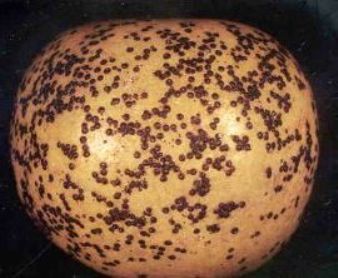|
California Red Scale
View more pictures: Bing Images Google Images Yahoo Images Common names: California Red Scale Scientific name: Aonidiella aurantii Region: This scale can be found in southern United States. Life cycle: This insect produces several generations each year and overwinters in all stages. Physical Description: This 1/12 inch long, reddish brown scale is almost round with a small nipple at the center of the covering. The nymph is brown and is born live. Feeding characteristics: This pest attacks citrus fruit, fig, grape, and walnut, by feeding on all parts of the trees. Red Scale produce a toxic substance that can kill leaves and twigs, and is characterized by yellow spots. On green fruit, the yellow spot is a little larger than the scale, and on leaves, the spot extends through the other side. Citrus fruit is especially susceptible to serious injuries. Controls: If your problem is on citrus fruit, lemons can be sprayed with dormant oil in April and May, while other citrus should not be sprayed until late summer or fall. Navel oranges are most susceptible to the Red Scale and the timing on spraying is critical. Moreover, maturing fruit should never be sprayed, since this could cause discolored and degraded fruit. In California, stop spraying when temperatures begin to reach 90 degrees F in coastal areas, 85 degrees in intermediate areas, and 95 degrees in interior areas, or if humidity levels dip below 35, 30, or 20 percent respectively. Various Chalcid Wasps, such as, Aphytis lingnanensis and Prospaltella perniciosi in coastal areas, and Aphytis melinus and Comperiella bifasciata in interior areas are important enemies of the Red Scale. These wasps are most effective if other conditions, not favorable to the scale, are present. Such conditions include favorable weather, control of Ants, and little dust or dirt on the trees. Return from California Red Scale to Insects A-D Encyclopedia of Garden Insects |
